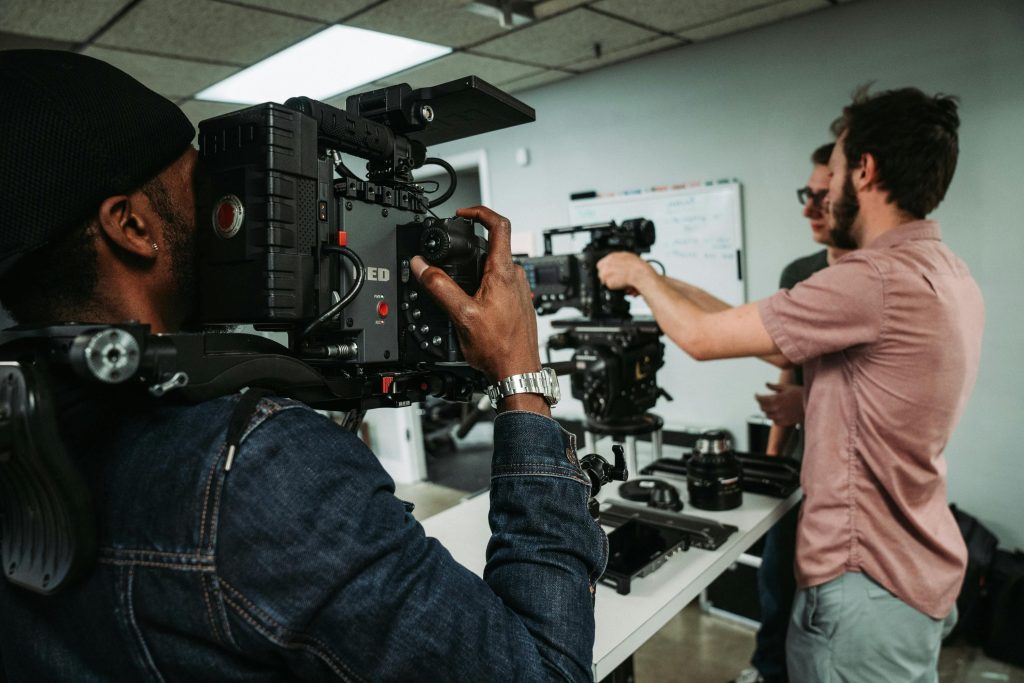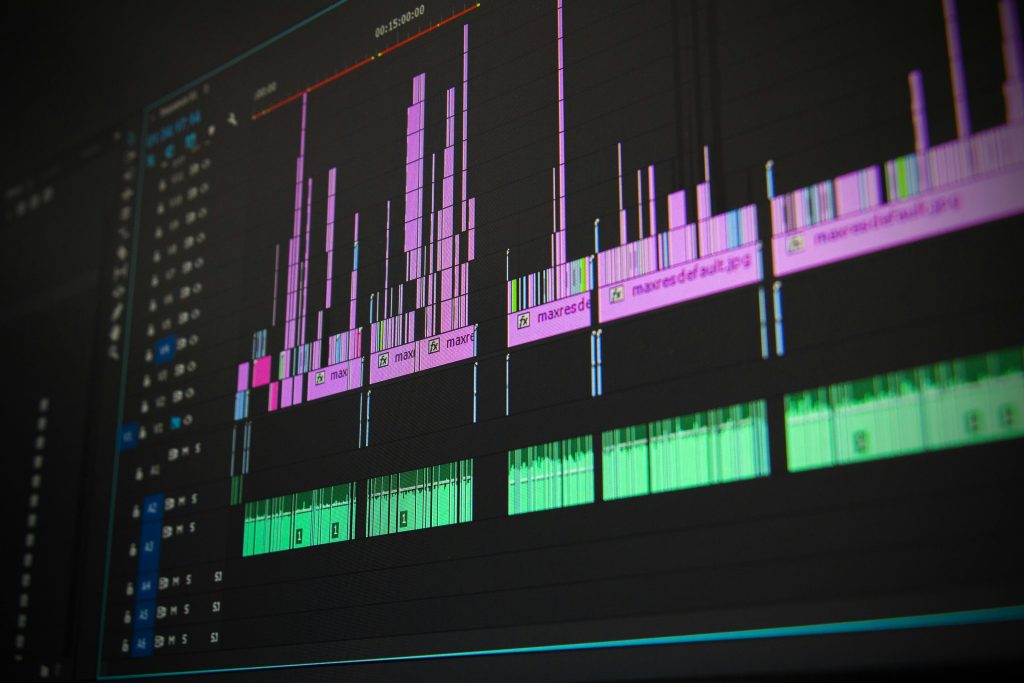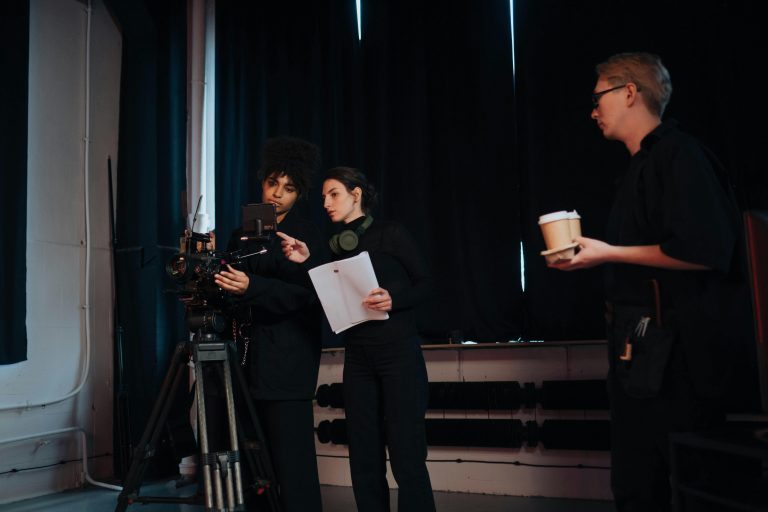
The Ultimate Guide to Corporate Video Production in 2024
Event video production has become an essential tool in capturing the essence of significant occasions, from corporate events to personal celebrations. As a beginner stepping into the world of event video production, especially in a dynamic city like NYC, it can seem overwhelming. This guide simplifies the process into six easy steps, helping you produce engaging and high-quality videos that effectively capture the spirit of any event.
Table of Contents
Key Takeaways
✔️ Pre-production: Plan goals, create storyboard, manage logistics, and budget.
✔️ Team Building: Match skills for successful video production, whether professionals or a DIY group.
✔️ Equipment Choice: Select appropriate cameras, audio, and lighting gear for high-quality footage.
✔️ Event Shooting: Balance preparation and adaptability to capture key moments creatively and effectively.
✔️ Post-production: Edit, mix sound, and add effects to transform raw footage into a polished narrative.
✔️ Special Effects: Use carefully to enhance the video without overshadowing the event’s essence.
1. Pre-Production Planning
Pre-production in filmmaking is a crucial foundational step where significant effort and thorough planning transform a concept into a viable project, directly impacting the quality of the final production. This phase involves meticulous preparation and strategic planning to ensure your event video production captures the essence of your event effectively. Below, we break down the crucial elements of pre-production planning.
Understanding Your Event and Objectives
- Defining Your Vision: Clarify what you want to achieve with the event video production. Is it to create a memorable keepsake, promote your brand, or share the experience with those who couldn’t attend?
- Event Specifics: Understand the type of event you are organizing, whether it’s a corporate event, a wedding, a concert, or a personal celebration. Each event type has different video production needs.
Creating a Concept and Storyline
- Developing a Theme: Build a theme or concept that aligns with the nature of your event video production. This will guide the style and tone of your video.
- Storyboarding: Sketch a basic storyboard or outline to visualize the sequence of the video. This helps in planning the shots and ensuring that all key moments are captured.
Scouting the Venue
- Location Visit: If possible, visit the venue to get a feel for the space. Look for potential shooting spots, understand the lighting conditions, and identify any challenges you might face during the actual event.
- Technical Reconnaissance: Assess the acoustics, power supply, and any other technical aspects that might affect your video production.
Planning the Shoot
- Timeline Creation: Develop a timeline for your event day, detailing when and what you will be filming. This is especially important for events with multiple activities or locations.
- Equipment and Shot List: List the equipment you’ll need and create a shot list to ensure you don’t miss any important moments.
Budgeting and Resource Allocation
- Budgeting: Determine how much you are willing to spend on video production. This includes equipment rental, additional crew if needed, and post-production costs.
- Resource Planning: Decide whether you’ll need to hire professional help, like a videographer or an editor, or if you can manage with the resources you have.
Finalizing Your Plan
- Review and Adjust: Once you have all the details, review your plan to ensure it aligns with your event’s goals and your vision for the video.
- Flexibility: Be prepared to make adjustments. Events can be unpredictable, and being flexible will help you adapt to last-minute changes.
2. Assembling the Right Team
Assembling the right team is a critical step in the process of event video production, especially in a city as dynamic as NYC. The success of your video greatly depends on the skills and coordination of your team. Here, we’ll explore the key aspects of putting together a team that can effectively bring your vision to life.
Understanding the Roles in a Video Production Team
- Director of Project Lead: Responsible for overseeing the event video production, ensuring that the vision is effectively translated into the video.
- Videographer/Cinematographer: Handles the camera work, capturing the footage in line with the director’s vision.
- Sound Technician: Manages the audio aspects, ensuring clear sound quality, which is essential in a noisy environment like NYC.
- Editor: In charge of post-production, piecing together the footage, adding effects, and music, and ensuring the final product is polished.
- Additional Crew: Depending on the scale of your event, you might need assistants, lighting technicians, or additional camera operators.
Choosing Between Professionals and DIY
- Hiring Professionals: For high-stakes events, particularly corporate ones, hiring a professional team ensures a high-quality event video production. Professionals bring experience and expertise that can significantly elevate your video production.
- DIY Approach: If you’re working with a limited budget or if the event is more personal, a DIY approach can be more suitable. Leveraging the skills of friends or colleagues who have a knack for videography or editing can be a cost-effective solution.
Communication and Collaboration Within the Team
- Pre-Event Meetings: Organize meetings with your team to discuss the event details, your expectations, and any specific requirements you have for the video.
- Collaborative Tools: Utilize collaborative tools and platforms to keep everyone on the same page, especially important in a city like NYC where team members might be spread out.
- Feedback Loop: Establish a system for regular feedback and updates throughout the video production process. This ensures any issues are addressed promptly and keeps the project on track.
Balancing Skillset and Budget
- Assessing Skills Needs: Determine the skill level required for your event video production. A large, high-profile event may necessitate experienced professionals, whereas a smaller, more intimate event might be successfully captured with less experienced individuals.
- Budget Allocation: Allocate your budget based on the priorities and scale of your event. Invest more in skilled professionals for aspects like sound and editing, which can significantly impact the final quality of your video.

3. Selecting the Right Equipment
Choosing the right equipment is crucial in event video production, especially in a place like NYC where events can range from intimate gatherings to grand-scale productions. The quality and suitability of your equipment can significantly influence the final output of your video.
Camera Selection
- Types of Cameras: Understand the different types of cameras available, such as DSLRs, mirrorless cameras, and professional camcorders. Each has its own set of advantages depending on the event’s requirements.
- Factors to Consider: Look at factors like low-light performance, color accuracy, and image stabilization. For events with a lot of movement, a camera with good image stabilization is vital.
- Multiple Cameras: Consider using multiple cameras for larger events. This allows for capturing various angles and can add dynamism to your video.
Why Good Audio Equipment Matters
- Microphones: Choose the right type of microphone for your event. Lapel mics are great for interviews, while shotgun mics are better suited for capturing ambient sounds.
- Audio Recorders: For high-quality sound, external audio recorders can be used in conjunction with microphones.
- Monitoring Audio: Ensure you have headphones to monitor audio quality during the event. In a city like NYC, ambient noise can be a challenge, and real-time monitoring is essential.
Lighting Essentials for Event Videography
- Natural vs. Artificial Lighting: Assess the lighting conditions of your event venue. If your event is indoors or in the evening, additional lighting equipment may be necessary.
- Types of Lights: Explore different lighting options like LED panels, softboxes, or ring lights, depending on the type of event and desired effect.
- Lighting Techniques: Familiarize yourself with basic lighting techniques to enhance the visual appeal of your footage, such as three-point lighting for interviews or softer lighting for ambient scenes.
4. Shooting the Event
The shooting phase is where your event video production truly comes to life. In a bustling city like NYC, with its unique dynamics and energy, capturing the essence of your event requires a blend of technical skills and creative vision. Here’s how you can ensure a successful shoot for your event.
Preparing for the Shoot
- Arrival and Setup: Plan to arrive early to set up your equipment and do a final walk-through of the venue for your event video production.
- Final Briefing with the Team: Conduct a final meeting with your team to go over the plan, discuss any last-minute changes, and ensure everyone is clear on their roles.
Capturing High-Quality Footage
- Covering Key Moments: Make sure to capture the essential parts of the event, such as speeches at a corporate event, the exchange of vows at a wedding, or the headline act at a concert.
- Creative Shots: Don’t just stick to the basics; look for creative angles and shots that add a unique perspective to your video.
Shooting Techniques
- Wide Shots and Close-Ups: Use a mix of wide shots to establish the scene and close-ups to capture details and emotions.
- Camera Movement: Incorporate movements like panning, tilting, or using a gimbal for smooth motion shots to add dynamism to your video.
- Angles and Perspectives: Experiment with different angles and perspectives to make your video more engaging.
Managing Lighting and Sound Challenges
- Adapting to Lighting Conditions: Continuously adjust your camera settings to accommodate changing lighting conditions, especially for events that transition from day to night.
- Sound Quality: Pay attention to the sound quality, especially in noisy environments. Use external microphones and recorders to capture clear audio for your event video production.
Being Adaptive and Responsive
- Dealing with Unexpected Situations: Be prepared to adapt to unforeseen circumstances, such as changes in the event schedule or technical difficulties.
- Capturing Spontaneous Moments: Keep an eye out for spontaneous moments that often make for the most memorable and authentic parts of your video.

5. Post-Production Magic
After successfully capturing your event, the next critical phase in event video production is post-production. This stage is where all your footage is transformed into a cohesive, engaging narrative. Post-production is vital in film production, where the true meaning and message of the project are crafted through careful editing and utilization of the recorded footage. In NYC, where the standards for quality and creativity are high, excellent post-production work can set your video apart.
Here’s how to navigate this crucial phase.
Editing Software and Tools
- Choosing the Right Software: Select an editing software that best suits your needs for your event video production. Options range from beginner-friendly software like iMovie or Adobe Premiere Rush to more advanced options like Adobe Premiere Pro or Final Cut Pro.
- Familiarization with the Interface: Spend time getting to know the software interface. Understanding the tools and features available to you is crucial for efficient editing.
Basic Editing Techniques
- Assembling Footage: Start by assembling your footage in a logical sequence that tells the story of your event.
- Cutting and Trimming: Trim and cut your clips to include only the best footage. Pay attention to pacing and rhythm to maintain viewer engagement.
- Transitions: Use transitions wisely to maintain a smooth flow between scenes. Avoid overusing them, as this can be distracting.
Adding Music and Sound Effects
- Music Selection: Choose music that complements the tone and mood of your event. Music can greatly enhance the emotional impact of your video.
- Sound Effects: Use sound effects sparingly to add depth and realism to your video, especially important in capturing the vibrant soundscape of NYC.
Incorporating Graphics and Text Overlays
- Graphics: Use graphics to add a professional touch to your video, like opening titles, lower thirds for speaker names, or end credits.
- Text Overlays: If your video includes important information or needs context, text overlays can be a useful tool. Ensure they are legible and not overly distracting.
Color Correction and Grading
- Balancing Colors: Adjust the color balance to ensure your footage looks natural and consistent throughout the video.
- Color Grading: Color grading can be used to set the mood and style of your video. For instance, a warmer color palette can give your video a more inviting feel.
Exporting the Final Video for Different Platforms
- Understanding Formats and Resolutions: Different platforms may have specific requirements for video formats and resolutions. Make sure you’re aware of these before exporting.
- Compression and Quality: Balance the compression settings to ensure your video maintains high quality without being unnecessarily large in file size, especially important when sharing videos online.

6. Enhancing with Special Effects and Animation
Incorporating special effects and animation into your event video production can elevate the final product, making it stand out, especially in a city like NYC known for its high production values. While not always necessary, these elements can add an extra layer of polish and creativity to your video.
When and How to Use Special Effects
- Appropriate Use: Determine if special effects are appropriate for the type of event and the message of the video. For example, corporate events might benefit from subtle effects that enhance professionalism.
- Software for Special Effects: Utilize software like Adobe After Effects or similar programs that offer a range of special effects options.
Simple Animation Techniques
- Basic Animations: Learn basic animation techniques such as keyframing for smooth motion effects or transitions.
- Animated Graphics: Incorporate animated graphics, such as moving text or logos, to add a dynamic element to your video.
Tools and Software for Special Effects and Animation
- Selecting Software: Choose the right software that suits your skill level and the needs of your project. Software like Adobe After Effects or Apple Motion offers extensive features for animation and effects.
- Tutorials and Learning Resources: Take advantage of online tutorials and resources to learn how to effectively use these tools.
Balancing Effects with the Overall Theme of the Event
- Consistency with Event Theme: Ensure that any effects or animations you use are consistent with the theme and tone of the event. The effects should enhance, not detract from, the event’s message.
- Avoid Overuse: Be cautious not to overuse effects and animations. Overdoing it can make your video feel cluttered and distract from the actual content.
Creative Use of Special Effects and Animation
- Enhancing Storytelling: Use effects and animations to enhance the storytelling aspect of your video. They can be used to emphasize key moments or convey particular emotions.
- Custom Animations: For a unique touch, consider creating custom animations that align with the event’s branding or theme.
FAQs (Frequently Asked Questions)
1. What are the key components of pre-production planning in event video production?
Key components include understanding client needs and objectives, creating a storyboard or script, scouting the event location, scheduling and logistics, and budget considerations. This phase sets the foundation for a successful video by outlining the event’s goals, visualizing the final product, and ensuring all logistical aspects are addressed.
2. How do I choose the right equipment for my event video production?
The choice of equipment depends on the type of event, the desired quality of the video, and your budget. Key equipment includes a suitable camera (like DSLRs, mirrorless cameras, or camcorders), good-quality audio equipment (like microphones and recorders), and proper lighting. Consider additional gear like tripods and gimbals for stability, especially for dynamic events.
3. Is it necessary to hire a professional team for event video production, or can I do it myself?
This depends on the scale of your event and your expertise. For large or high-stakes events, especially in a corporate setting, hiring a professional team is advisable to ensure high-quality results. For smaller or more personal events, a DIY approach with some basic equipment and editing software might suffice.
4. What are some effective strategies for marketing and distributing my event video?
Effective strategies include choosing the right distribution platforms (like social media, YouTube, and your website), optimizing your video for SEO with relevant keywords and tags, creating engaging thumbnails and titles, and using email marketing. Engaging with your audience on social media and sharing behind-the-scenes content can also enhance visibility and engagement.
5. Can special effects and animation enhance my event video, and how should I use them?
Special effects and animation can significantly enhance your video if used appropriately. They should align with the event’s theme and not overshadow the event’s content. Use basic animations for smooth transitions and text overlays, and consider simple effects to highlight key moments. It’s important to balance these elements to avoid making your video feel cluttered or over-produced.
Hire NYC's Top Professionals for Your Corporate Video Production Needs
Elevate your brand’s presence in the bustling heart of NYC with professional Corporate Video Production. Whether you’re launching a new product, hosting a grand event, or simply looking to showcase your company’s story, our team of experts is here to bring your vision to life. With state-of-the-art equipment, creative storytelling, and a keen eye for detail, we promise to deliver a captivating video that resonates with your audience and sets you apart in the competitive New York City market. Don’t just blend in; let’s create a video that makes your brand stand out. Contact us today to start your corporate video production journey in NYC!

